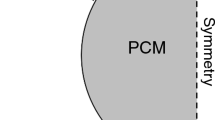Abstract
This paper reports a dynamic testing technique for measuring the effective thermal conductivity of phase change materials close to the melting point aiming at the compensation for the absence of such data. Based on Stefan model, the time dependence of the position of the phase interface in a cylindrical melting process, which implies the thermal conductivity, was successfully determined with the aid of the perturbation method. Thereafter, a series of experiments were conducted on a well-designed testing system with excellent heat insulation to collect relevant data of sodium acetate trihydrate. To bridge the gap between the experimental and the actual values, a 3-dimensional, unsteady, numerical model, taking convection into consideration, was built on CFD code. Under necessary assumptions, this model allowed a better understanding of the role of the convection playing in the experiments. Accurate results of approximation to experimental data were obtained by continually adjusting the iterative value. The maximum deviation was limited in 9 %.








Similar content being viewed by others
References
Lane GA. Solar heat storage: latent heat materials. Boca Raton: CRC Press; 1983.
Farid MM, Khudhair AM, Razack SAK, Al-Hallaj S. A review on phase change energy storage: materials and applications. Energ Convers Manag. 2004;45:1597–615.
Pillai KK, Brinkwarth BJ. The storage of low grade thermal energy using phase change materials. Appl Energ. 1976;2:205–16.
Zeng JL, Gao Z, Yang DY, Sun LX, Zhang L. Thermal conductivity enhancement of Ag nanowires on an organic phase change material. J Therm Anal Calorim. 2010;101:385–9.
Rady M. Granular phase change materials for thermal energy storage: experiments and numerical simulations. Appl Therm Eng. 2009;29:3149–59.
Kravvaritis ED, Antonopoulos KA, Tzivanidis C. Experimental determination of the effective thermal capacity function and other thermal properties for various phase change materials using the thermal delay method. Appl Energ. 2011;88:4459–69.
Oró E, Gracia AD, Castell A, Farid MM, Cabeza LF. Review on phase change materials (PCMs) for cold thermal energy storage applications. Appl Energ. 2012;99:513–33.
Desgrosseilliers L, Whitman CA, Groulx D, White MA. Dodecanoic acid as a promising phase-change materials for thermal energy storage. Appl Therm Eng. 2013;53:37–41.
Howell BA, Cho YJ. Thermal properties of poly(styrene) containing brominated aryl phosphate additives. J Therm Anal Calorim. 2006;85:73–8.
Parameshwaran R, Jayavel R, Kalaiselvam S. Study on thermal properties of organic ester phase-change material embedded with silver nanoparticles. J Therm Anal Calorim. 2013. doi:10.1007/s10973-013-3064-9.
Li M, Wu ZS. Thermal properties of the graphite/n-docosane composite PCM. J Therm Anal Calorim. 2013;. doi:10.1007/s10973-012-2218-5.
Zhang P, Kang M, Hu Y. Influence of layered zinc hydroxide nitrate on thermal properties of paraffin/intumescent flame retardant as a phase change material. J Therm Anal Calorim. 2013;112:1199–205.
Wang N, Zhang XR, Zhu DS, Gao JW. The investigation of thermal conductivity and energy storage properties of graphite/paraffin composites. J Therm Anal Calorim. 2013;107:949–54.
Zhou JM, Liu JJ, Lamvik M. An experimental method for measurement of the thermal conductivity of material at the melting/freezing point. Phys Exam Test. 1999;5:32–4.
Li CG, Zhou JM. A new method for dynamic measurement and calculation of thermophysical properties of metal materials at the melting point. Energ Metall Ind. 2003;22(4):57–61.
Li CG, Zhou JM. Medium/High melting metals: measurement of coefficient of thermal conductivity at the point of solid–liquid transition. Electron Compon Mater. 2003;22(10):42–5.
Zhan SQ, Zhou JM, Wu Y, Li Y, Liang YN, Yang Y. Dynamic measurement of thermophysical properties of molten salt and error correction method. J CIESC. 2012;63(8):2341–7.
Crank J. Free and moving boundary problems. Oxford: Clarendon Press; 1984.
Caldwell J, Kwan YY. On the perturbation method for the Stefan problem with time-dependent boundary conditions. Int J Heat Mass Trans. 2003;46:1497–501.
Zhang RY. Phase change materials and phase change energy storage technology. Princeton, NJ: Science Press; 2009.
Kravvaritis ED, Antonopoulos KA, Tzivanidis C. Improvements to the measurement of the thermal properties of phase change materials. Meas Sci Technol. 2010;21:045103.
Yang XH, Lu TJ, Kim T. Temperature effects on the effective thermal conductivity of phase change materials with two distinctive phases. Int Commun Heat Mass. 2011;38:1344–8.
Keinänen M. Latent heat recovery from supercooled sodium acetate trihydrate using a brush heat exchanger. Master’s Thesis: Helsinki University of Technology, Helsinki; 2007 (in Finland).
Araki N, Futamura M, Makino A, Shibata H. Measurements of thermophysical properties of sodium acetate hydrate. Int J Thermophys. 1995;16(6):1455–66.
Nie GH, Zhang ZY. Measurement of the thermal conductivities of CH3COONa·3H2O, CH3COOLi·2H2O, and Na2S2O3·5H2O in the temperature range from 10 °C to 80 °C. J. Northwest Univ. (Nat Sci). 2001;31(6):492–5.
Acknowledgements
This study entirely funded by the National Natural Science Foundation of China under award number 50876116.
Author information
Authors and Affiliations
Corresponding author
Rights and permissions
About this article
Cite this article
Peng, W., Zhou, Jm., Li, Y. et al. A dynamic technique for the measurement of thermal conductivity of molten salt based on cylindrical melting model. J Therm Anal Calorim 115, 1767–1777 (2014). https://doi.org/10.1007/s10973-013-3386-7
Received:
Accepted:
Published:
Issue Date:
DOI: https://doi.org/10.1007/s10973-013-3386-7




